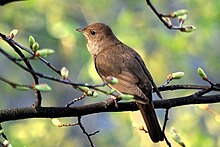Thrush nightingale
| Thrush nightingale | |
|---|---|
 |
|
| At Uglich, Russia | |
| Scientific classification | |
| Kingdom: | Animalia |
| Phylum: | Chordata |
| Class: | Aves |
| Order: | Passeriformes |
| Family: | Muscicapidae |
| Genus: | Luscinia |
| Species: | L. luscinia |
| Binomial name | |
|
Luscinia luscinia (Linnaeus, 1758) |
|
The thrush nightingale (Luscinia luscinia), also known as the sprosser, is a small passerine bird that was formerly classed as a member of the thrush family Turdidae, but is now more generally considered to be an Old World flycatcher, Muscicapidae. It, and similar small European species, are often called chats.
It is a migratory insectivorous species breeding in forests in Europe and Asia and overwintering in Africa. The distribution is more northerly than the very closely related common nightingale, Luscinia megarhynchos, which it closely resembles in appearance. It nests near the ground in dense undergrowth.
The thrush nightingale is similar in size to the European robin. It is plain greyish-brown above and white and greyish-brown below. Its greyer tones, giving a cloudy appearance to the underside, and lack of the common nightingale's obvious rufous tail side patches are the clearest plumage differences from that species. Sexes are similar. It has a similar but more powerful song than that of the nightingale.
"Nightingale" is derived from "night", and the Old English galan, "to sing". The genus name Luscinia is Latin for the common nightingale.
An adult thrush nightingale is about 16 centimetres (6.3 in) long with a wingspan of approximately 18 centimetres (7.1 in). The head, nape and the whole of the upper parts of the thrush nightingale are dark brown with a slight olive tinge. The colour is much deeper than that of the nightingale and is not at all rufous. The upper tail-coverts are less olivaceous and the tail feathers are dark rufous-brown. The lores and ear-coverts are brownish-black and the chin and throat are pale buff or whitish, mottled with brown, and are paler in colour than the nightingale. The sides of the throat are spotted brown and the pale feathers of the breast have brown central bands giving the breast a mottled appearance. The under tail-coverts are buff, sometimes barred or marked with brown. The wing feathers and wing-coverts are dark brown and less rufous than the nightingale. The beak, legs and feet are brown and the irises are dark brown. The sexes are similar to each other in appearance and the juveniles are darker and more mottled. There is a single moult in July and August at the end of the breeding season.
...
Wikipedia

